Page 260 of 416
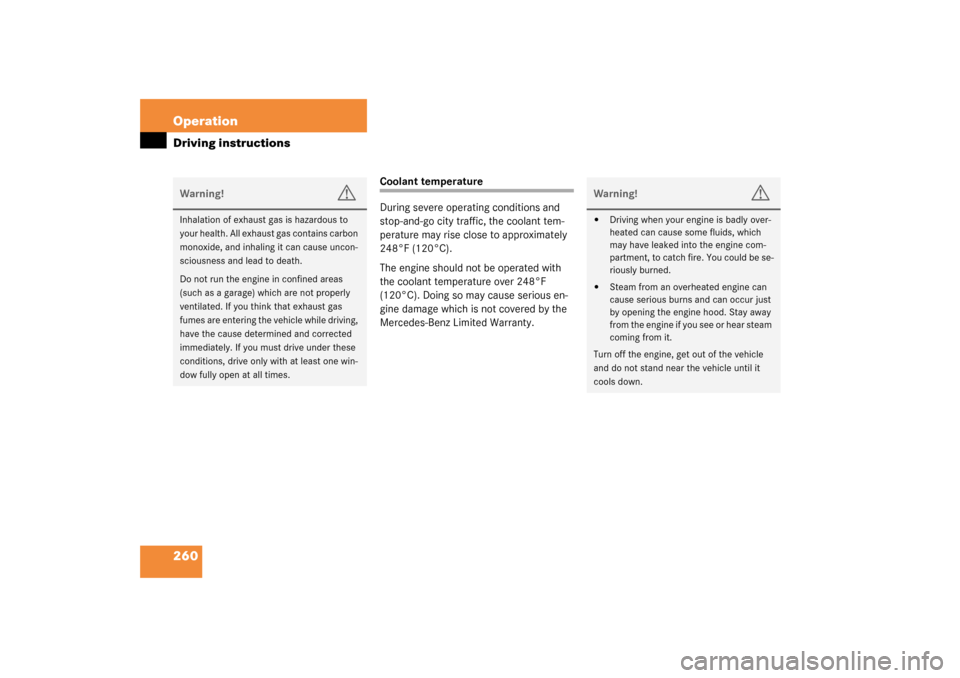
260 OperationDriving instructions
Coolant temperature
During severe operating conditions and
stop-and-go city traffic, the coolant tem-
perature may rise close to approximately
248°F (120°C).
The engine should not be operated with
the coolant temperature over 248°F
(120°C). Doing so may cause serious en-
gine damage which is not covered by the
Mercedes-Benz Limited Warranty.
Warning!
G
Inhalation of exhaust gas is hazardous to
your health. All exhaust gas contains carbon
monoxide, and inhaling it can cause uncon-
sciousness and lead to death.
Do not run the engine in confined areas
(such as a garage) which are not properly
ventilated. If you think that exhaust gas
fumes are entering the vehicle while driving,
have the cause determined and corrected
immediately. If you must drive under these
conditions, drive only with at least one win-
dow fully open at all times.
Warning!
G
�
Driving when your engine is badly over-
heated can cause some fluids, which
may have leaked into the engine com-
partment, to catch fire. You could be se-
riously burned.
�
Steam from an overheated engine can
cause serious burns and can occur just
by opening the engine hood. Stay away
f r o m t h e e n g i n e i f y o u s e e o r h e a r s t e a m
coming from it.
Turn off the engine, get out of the vehicle
and do not stand near the vehicle until it
cools down.
Page 262 of 416
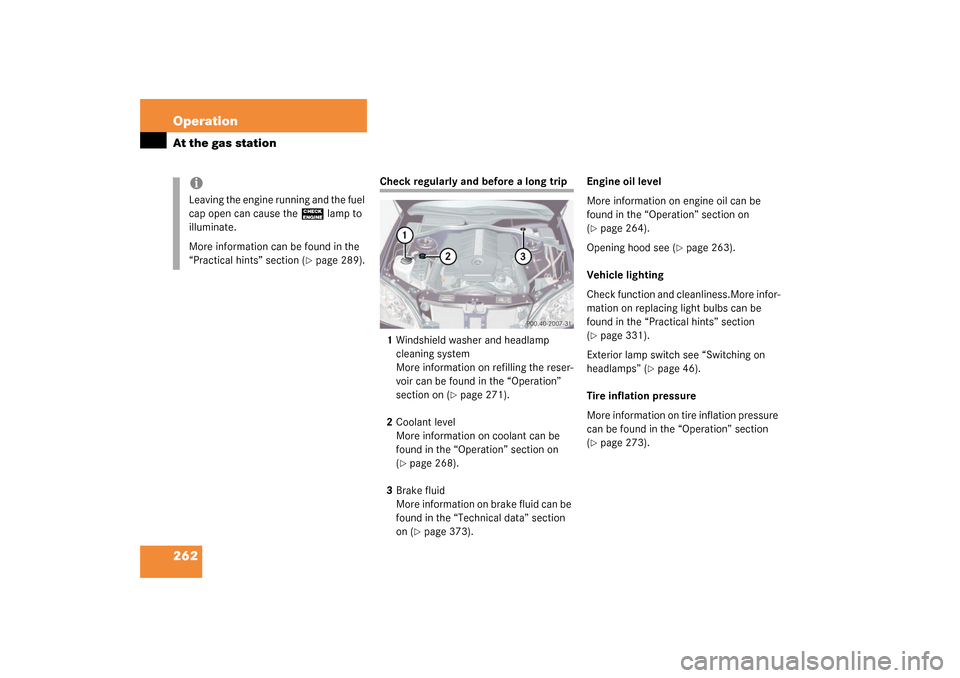
262 OperationAt the gas station
Check regularly and before a long trip
1Windshield washer and headlamp
cleaning system
More information on refilling the reser-
voir can be found in the “Operation”
section on (
�page 271).
2Coolant level
More information on coolant can be
found in the “Operation” section on
(
�page 268).
3Brake fluid
More information on brake fluid can be
found in the “Technical data” section
on (�page 373).Engine oil level
More information on engine oil can be
found in the “Operation” section on
(
�page 264).
Opening hood see (
�page 263).
Vehicle lighting
Check function and cleanliness.More infor-
mation on replacing light bulbs can be
found in the “Practical hints” section
(
�page 331).
Exterior lamp switch see “Switching on
headlamps” (
�page 46).
Tire inflation pressure
More information on tire inflation pressure
can be found in the “Operation” section
(
�page 273).
iLeaving the engine running and the fuel
cap open can cause the
?
lamp to
illuminate.
More information can be found in the
“Practical hints” section (
�page 289).
Page 263 of 416

263 Operation
Engine compartment
Engine compartment
Hood
Opening
The hood lock release lever is located in
the driver’s footwell to the left of the park-
ing brake pedal.
1Hood lock release
�
Pull lever 1 towards you in the direction
of the arrow.
The hood is unlocked and handle2 will
extend out of the radiator grill.
2Handle for opening the hood
�
Pull handle 2 to its stop out of radiator
grill.
�
Pull up on the hood (do not pull up on
the handle) and then release it.
The hood will be automatically held
open at shoulder height by gas-filled
struts.
Warning!
G
Do not pull the release lever while the vehi-
cle is in motion. Otherwise the hood could
be forced open by passing air flow.
!To avoid damage to the windshield wip-
ers or hood, never open the hood if the
wiper arms are folded forward away
from the windshield.
Warning!
G
To help prevent personal injury, stay clear of
moving parts when the hood is open and the
engine is running. Make sure the hood is
properly closed before driving. When closing
the hood, use extreme caution not to catch
hands or fingers.
The radiator fan may continue to run for ap-
proximately 30 seconds or even restart af-
ter the engine has been turned off. Stay
clear of fan blades.
Page 264 of 416
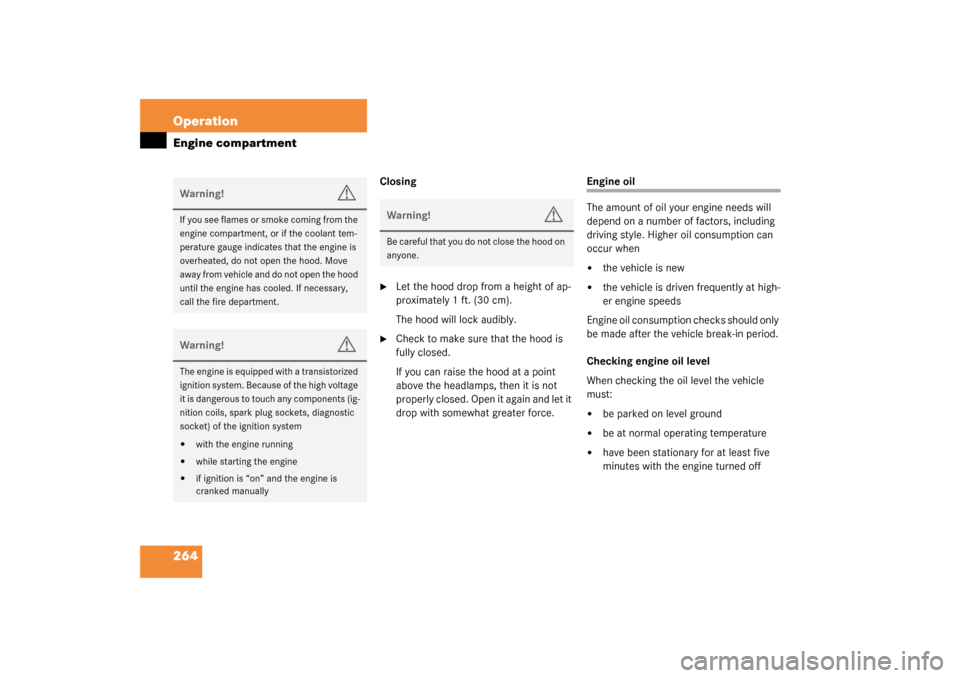
264 OperationEngine compartment
Closing�
Let the hood drop from a height of ap-
proximately 1 ft. (30 cm).
The hood will lock audibly.
�
Check to make sure that the hood is
fully closed.
If you can raise the hood at a point
above the headlamps, then it is not
properly closed. Open it again and let it
drop with somewhat greater force.
Engine oil
The amount of oil your engine needs will
depend on a number of factors, including
driving style. Higher oil consumption can
occur when�
the vehicle is new
�
the vehicle is driven frequently at high-
er engine speeds
Engine oil consumption checks should only
be made after the vehicle break-in period.
Checking engine oil level
When checking the oil level the vehicle
must:
�
be parked on level ground
�
be at normal operating temperature
�
have been stationary for at least five
minutes with the engine turned off
Warning!
G
If you see flames or smoke coming from the
engine compartment, or if the coolant tem-
perature gauge indicates that the engine is
overheated, do not open the hood. Move
away from vehicle and do not open the hood
until the engine has cooled. If necessary,
call the fire department.Warning!
G
The engine is equipped with a transistorized
ignition system. Because of the high voltage
it is dangerous to touch any components (ig-
nition coils, spark plug sockets, diagnostic
socket) of the ignition system�
with the engine running
�
while starting the engine
�
if ignition is “on” and the engine is
cranked manually
Warning!
G
Be careful that you do not close the hood on
anyone.
Page 265 of 416
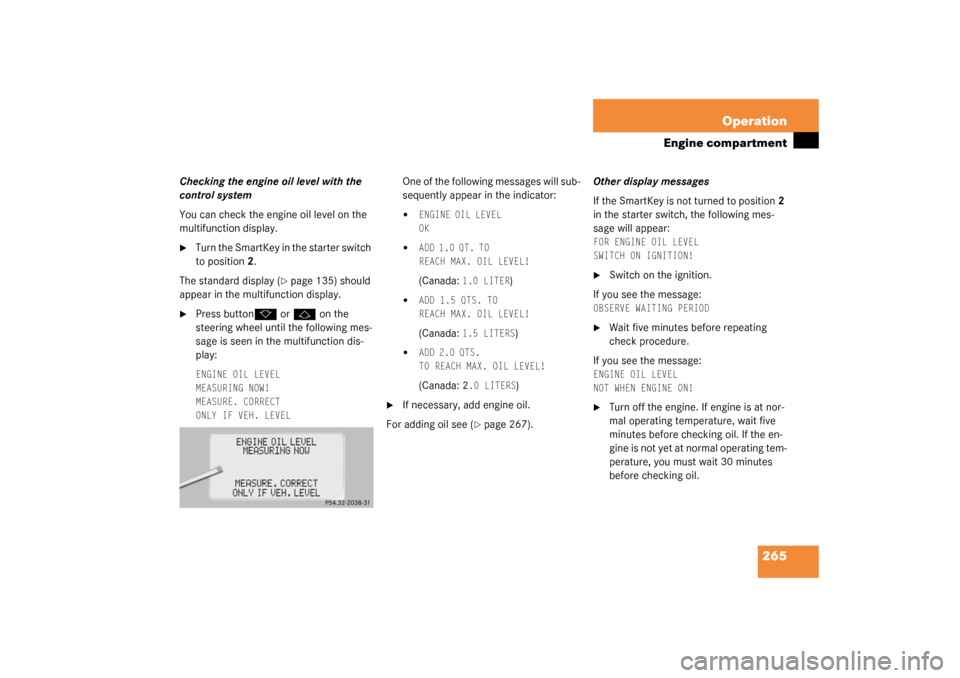
265 Operation
Engine compartment
Checking the engine oil level with the
control system
You can check the engine oil level on the
multifunction display.�
Turn the SmartKey in the starter switch
to position2.
The standard display (
�page 135) should
appear in the multifunction display.
�
Press button
k
or
j
on the
steering wheel until the following mes-
sage is seen in the multifunction dis-
play:
ENGINE OIL LEVEL
MEASURING NOW!
MEASURE. CORRECT
ONLY IF VEH. LEVEL
One of the following messages will sub-
sequently appear in the indicator:�
E N G I N E O I L L E V E L
OK
�
A D D 1 . 0 Q T . T O
REACH MAX. OIL LEVEL!(Canada:
1.0 LITER
)
�
ADD 1.5 QTS. TO
REACH MAX. OIL LEVEL!(Canada:
1.5 LITERS
)
�
A D D 2 . 0 Q T S .
TO REACH MAX. OIL LEVEL!(Canada: 2
.0 LITERS
)
�
If necessary, add engine oil.
For adding oil see (
�page 267).Other display messages
If the SmartKey is not turned to position 2
in the starter switch, the following mes-
sage will appear:
FOR ENGINE OIL LEVEL
SWITCH ON IGNITION!�
Switch on the ignition.
If you see the message:
OBSERVE WAITING PERIOD�
Wait five minutes before repeating
check procedure.
If you see the message:
ENGINE OIL LEVEL
NOT WHEN ENGINE ON!�
Turn off the engine. If engine is at nor-
mal operating temperature, wait five
minutes before checking oil. If the en-
gine is not yet at normal operating tem-
perature, you must wait 30 minutes
before checking oil.
Page 266 of 416
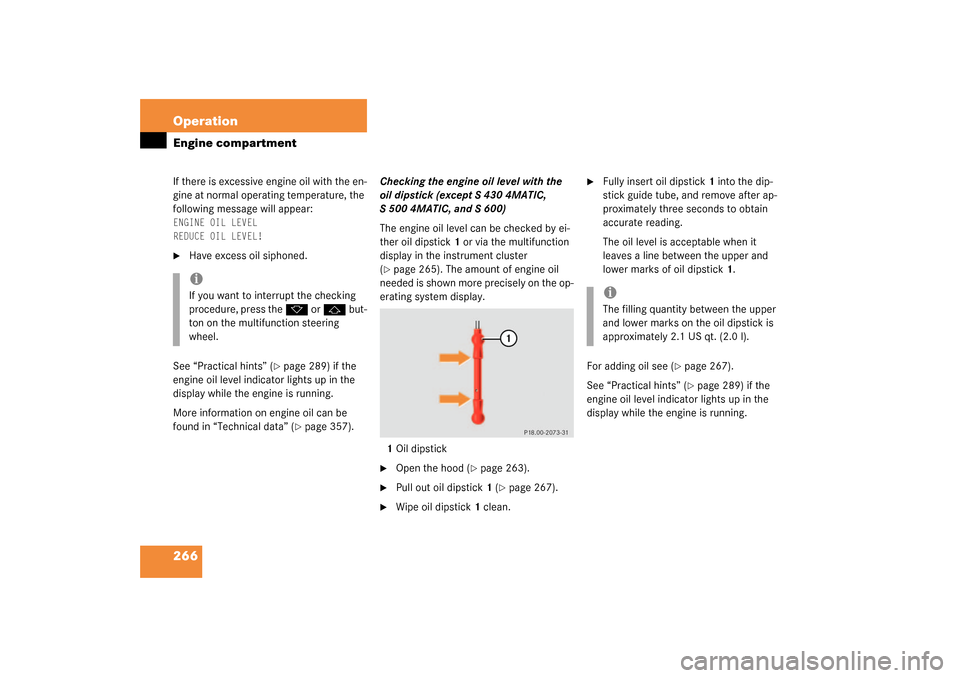
266 OperationEngine compartmentIf there is excessive engine oil with the en-
gine at normal operating temperature, the
following message will appear:ENGINE OIL LEVEL
REDUCE OIL LEVEL!�
Have excess oil siphoned.
See “Practical hints” (
�page 289) if the
engine oil level indicator lights up in the
display while the engine is running.
More information on engine oil can be
found in “Technical data” (�page 357).Checking the engine oil level with the
oil dipstick (except S 430 4MATIC,
S 500 4MATIC, and S 600)
The engine oil level can be checked by ei-
ther oil dipstick1 or via the multifunction
display in the instrument cluster
(
�page 265). The amount of engine oil
needed is shown more precisely on the op-
erating system display.
1Oil dipstick
�
Open the hood (
�page 263).
�
Pull out oil dipstick1 (
�page 267).
�
Wipe oil dipstick1 clean.
�
Fully insert oil dipstick1 into the dip-
stick guide tube, and remove after ap-
proximately three seconds to obtain
accurate reading.
The oil level is acceptable when it
leaves a line between the upper and
lower marks of oil dipstick 1.
For adding oil see (
�page 267).
See “Practical hints” (�page 289) if the
engine oil level indicator lights up in the
display while the engine is running.
iIf you want to interrupt the checking
procedure, press the
k
or
j
but-
ton on the multifunction steering
wheel.
iThe filling quantity between the upper
and lower marks on the oil dipstick is
approximately 2.1 US qt. (2.0 l).
Page 267 of 416
267 Operation
Engine compartment
Adding engine oilS 430, S 500, S 55 AMG1Oil dipstick
2Filler neck
S 6001Filler cap�
Unscrew the cap1 from filler neck.
�
Add engine oil as required. Be careful
not to overfill with oil.
Be careful not to spill any oil when adding.
Avoid environmental damage caused by oil
entering the ground or water.
�
Screw the cap back on the filler neck.!Excessive oil must be siphoned or
drained off. It could cause damage to
the engine and catalytic converter not
covered by the Mercedes-Benz Limited
Warranty.
Page 268 of 416
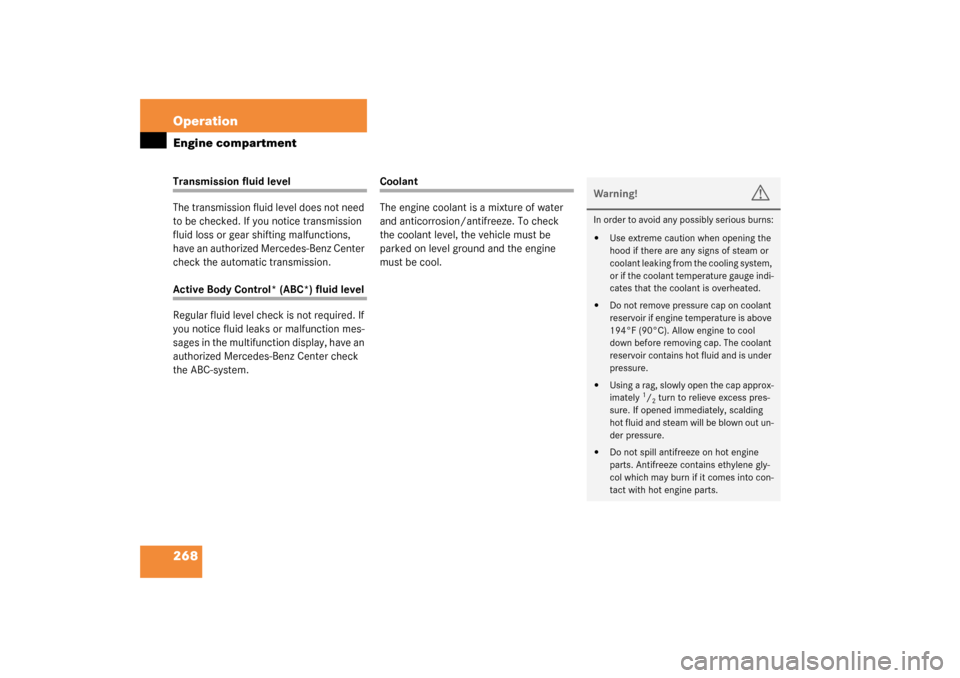
268 OperationEngine compartmentTransmission fluid level
The transmission fluid level does not need
to be checked. If you notice transmission
fluid loss or gear shifting malfunctions,
have an authorized Mercedes-Benz Center
check the automatic transmission.Active Body Control* (ABC*) fluid level
Regular fluid level check is not required. If
you notice fluid leaks or malfunction mes-
sages in the multifunction display, have an
authorized Mercedes-Benz Center check
the ABC-system.
Coolant
The engine coolant is a mixture of water
and anticorrosion/antifreeze. To check
the coolant level, the vehicle must be
parked on level ground and the engine
must be cool.
Warning!
G
In order to avoid any possibly serious burns:�
Use extreme caution when opening the
hood if there are any signs of steam or
coolant leaking from the cooling system,
or if the coolant temperature gauge indi-
cates that the coolant is overheated.
�
Do not remove pressure cap on coolant
reservoir if engine temperature is above
194°F (90°C). Allow engine to cool
down before removing cap. The coolant
reservoir contains hot fluid and is under
pressure.
�
Using a rag, slowly open the cap approx-
imately
1/2 turn to relieve excess pres-
sure. If opened immediately, scalding
hot fluid and steam will be blown out un-
der pressure.
�
Do not spill antifreeze on hot engine
parts. Antifreeze contains ethylene gly-
col which may burn if it comes into con-
tact with hot engine parts.